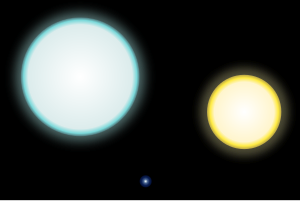 Image via Wikipedia
Image via WikipediaIn each case I will list the mass of the white dwarf and neutron star in solar masses, (meaning the mass of these objects after dividing my the mass of the sun) the ratio of the radius of the white dwarf to that of the neutron star and how much separation there is between the two objects initially in terms of white dwarf radii.
Case 1.
Mass of neutron star: 1.5
Mass of white dwarf: 0.98
RWD/RNS: 9.96
Initial separation: 4 white dwarf radii.
The plot above shows the results for this case. The neutron star is the object initially on the left, and the white dwarf is initially on the right. The lines are density contour lines and the more red the color the more dense the region. As you can see the neutron star is much smaller than the white dwarf and is much more dense.
I will let the authors describe what is happening as I think the description is good. However, given the technical language I am confessing in advance that the text has been heavily paraphrased in some sections:
In general, the head-on collision of white dwarf-neutron star systems can be decomposed into three phases: the acceleration, the plunge, and the quasiequilibrium phase.
During the acceleration phase, the two stars accelerate toward one another starting from rest. The separation decreases as a function of time and this phase ends when the two stars first make contact. As the separation decreases, the increasing neutron star's tidal field strongly distorts the white dwarf. This can be seen in the density contours plotted above. The neutron star's interior is almost unchanged during this phase. In reality, it oscillates but is not tidally distorted by the white dwarf. Nevertheless, the neutron star's atmosphere does expand.
During the plunge phase the neutron star penetrates the white dwarf, launching strong shocks that sweep through and heat the interior of the white dwarf. The neutron star's outermost layers are stripped when they encounter the dense central parts of the white dwarf's, and the neutron star is compressed. We find that at maximum compression in this, the neutron star's central density only increases by about 8% of the initial central density. Eventually, strong shocks sweep through the entire white dwarf's interior and then transfer linear momentum to the white dwarf's outer layers, a large fraction of which receives sufficient momentum to escape to infinity. We find that about 18% of the total mass is lost to infinity. Material that did not receive sufficient thrust to escape to infinity starts to rain down onto the neutron star-white dwarf combination and the plunge phase ends when this process is over.
During the quasiequilibrium phase the remnant settles into a spherical quasiequilibrium object whose outer layers oscillate. This can be seen in the two final snapshots of figure above, where we show that the inner equatorial restmass density contours do not change with time, while the outer layers change only a little. The white dwarf-neutron star final remnant consists of a cold neutron star core with a hot mantle on top.
The prompt collapse to a black hole does not take place in any of the cases studied because strong shock heating gives rise to a hot remnant. Ultimate collapse to a BH is almost certain after the remnant has cooled.Anyways, I was impressed how much matter is ejected during the collision to do heating. It's also interesting how the final combo's radii has increased while the core of the new object is that of a neutron star. I'd be curious if anyone here knows how abundant these types of abjects are in the universe.
These next two cases are qualitatively the same so I won't add any more commentary. But I am adding the cases anyways as they help see how mass and separation distance effect the processes.
Case 2.
Mass of neutron star: 1.5
Mass of white dwarf: 0.98
RWD/RNS: 4.99
Initial separation: 8 white dwarf radii.
Case 3.
Mass of neutron star: 1.5
Mass of white dwarf: 0.98
RWD/RNS: 20.01
Initial separation: 2 white dwarf radii.
I applaud the authors being able to simulate these collisions incorporating the effects of general relativity. These simulations have been most interesting to me.
Vasileios Paschalidis, Zachariah Etienne, Yuk Tung Liu, & Stuart L. Shapiro (2010). Head-on collisions of binary white dwarf--neutron stars: Simulations in
full general relativity Submitted to PRD. arXiv: 1009.4932v1



Come on Joe, you can write a better title than that. Try "What do you get when you cross a white dwarf with a neutron star?" To which the obvious answer is, "white dwarf neutron star sine theta."
ReplyDeleteQuantumleap42,
ReplyDeleteYes, you are right. I should have remembered you can take cross products of these objects. :)
This seems like a very theoretical exercise in that stars would not collide head on like this, but rather they would spiral in because they would be in a binary as the authors point out in the paper (a binary study is their future work and arguably much more physically relevant). It is interesting that they predict you wouldn't get a black hole right away. As the matter cools onto the central neutron star presumably the Tolman-Oppenheimer-Volkoff limit is reached and a black hole is formed; do they discuss a timescale for this?
ReplyDeleteThe Astronomist,
ReplyDeleteGood point about the spiraling in. As for the timescale for black hole formation. I didn't see one but I may have just missed it.
Quality articles or reviews is the secret to invite the visitors to pay a visit the web page, that's what this website is providing.
ReplyDeleteFeel free to visit my web blog; cellulite treatment reviews
Situated at the fringe of short distance to city, Sant Ritz at Potong Pasir (Singapore) in District
ReplyDelete13. the interlace condo (theinterlacecondo.sg)